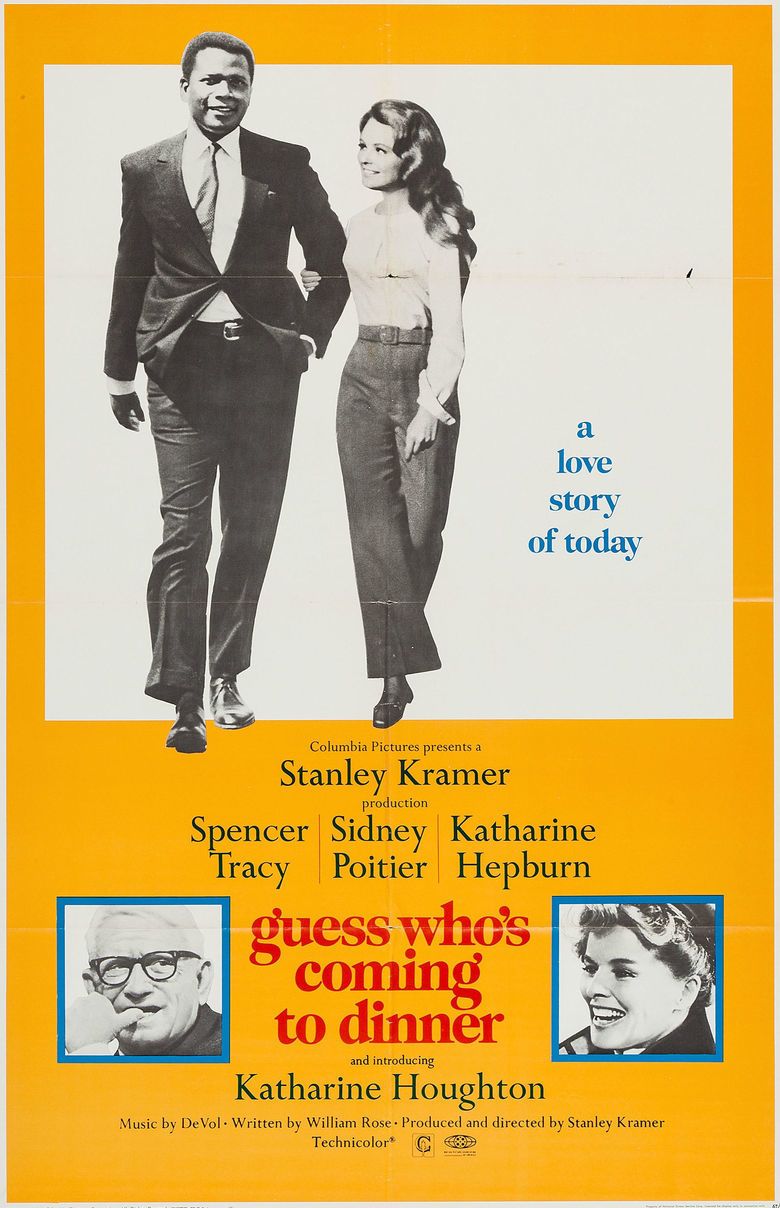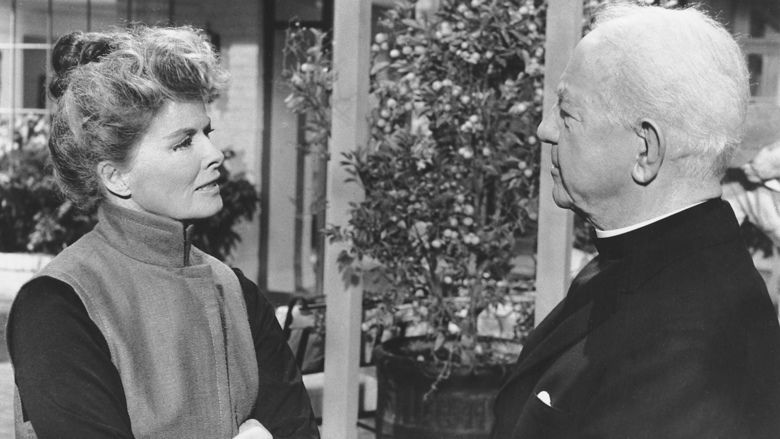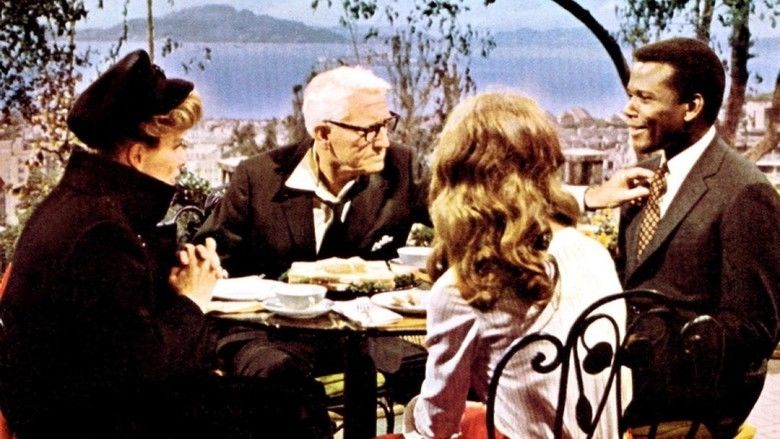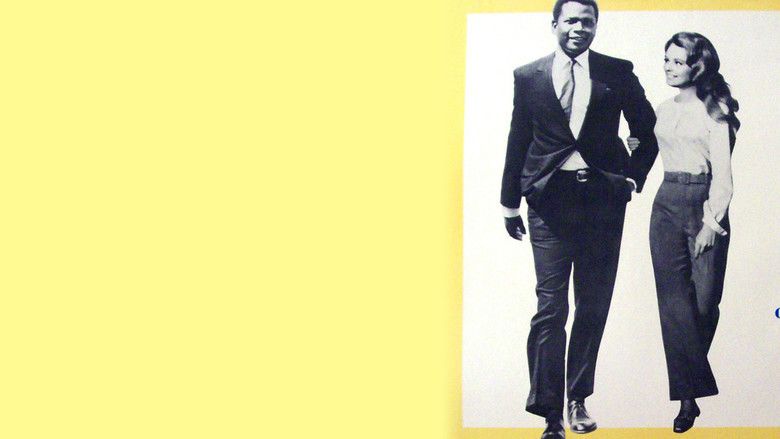Guess Whos Coming to Dinner
8.2 /10 1 Votes8.2
67% Rotten Tomatoes Language English | 7.8/10 IMDb 4/4 Roger Ebert Genre Comedy, Drama Duration Country United States | |||||||||||||||||||||||||||||||||
 | ||||||||||||||||||||||||||||||||||
Release date December 12, 1967 (1967-12-12) (United States) Cast (Matt Drayton), (Dr. John Wade Prentice), (Christina Drayton), (Joanna Drayton), (Tillie), (Carhop) Similar movies Ant-Man , Four Weddings and a Funeral , The Wedding Singer , Blackhat , Terminator Salvation , The Age of Adaline Tagline A love story of today | ||||||||||||||||||||||||||||||||||
Guess who s coming to dinner 3 8 movie clip parental approval 1967 hd
Guess Who's Coming to Dinner is a 1967 American comedy-drama film produced and directed by Stanley Kramer, and written by William Rose. It stars Spencer Tracy, Sidney Poitier, and Katharine Hepburn, and features Hepburn's niece Katharine Houghton. The film contains a (then rare) positive representation of the controversial subject of interracial marriage, which historically had been illegal in most states of the United States, and still was illegal in 17 states—mostly Southern states—until 12 June 1967, six months before the film was released, roughly two weeks after Tracy filmed his final scene (and two days after his death), when anti-miscegenation laws were struck down by the Supreme Court in Loving v. Virginia. The film's Oscar-nominated score was composed by Frank De Vol.
Contents
- Guess who s coming to dinner 3 8 movie clip parental approval 1967 hd
- Guess who s coming to dinner 7 8 movie clip you don t own me 1967 hd
- Plot
- Production
- Release
- Reception
- Variant versions
- Wins
- Nominations
- American Film Institute recognition
- Remakes
- Guess who s coming to dinner 6 8 movie clip get permanently lost 1967 hd
- Guess who s coming to dinner 1 8 movie clip pleased to meet you 1967 hd
- References

The film is notable for being the ninth and final on-screen pairing of Tracy and Hepburn, with filming ending just 17 days before Tracy's death. Hepburn never saw the completed film, saying the memories of Tracy were too painful. The film was released in December 1967, six months after his death.

Guess who s coming to dinner 7 8 movie clip you don t own me 1967 hd
Plot

Joanna Drayton's (Katharine Houghton) unannounced early return from a Hawaiian vacation causes a stir when she brings her new fiancé to her childhood upper-class home in San Francisco. He is John Prentice (Sidney Poitier): a widowed, black physician. Joanna's parents—newspaper publisher Matt Drayton (Spencer Tracy) and his wife art gallery owner Christina Drayton (Katharine Hepburn)—are purported liberals who have instilled in her the idea of racial equality. But although they try to hide it, Joanna's parents and in particular her father are initially upset that she is planning to marry a black man. The Draytons' black maid, Tillie (Isabel Sanford), is even more horrified, suspecting that John is trying to "get above himself" by marrying a white woman.

Joanna is oblivious to the reactions of her parents. They are unsettled by her engagement with John since they never thought that her choice would be a black man, and further unsettled by John's decision that if Joanna's parents do not accept the engagement that day, that he will end it.

Adding to the situation is that Joanna, at first intending to join John in a few weeks in Geneva for their planned marriage ceremony, has changed her mind to leave after dinner on his flight to New York City and then onward to Europe. She has also invited John's parents (Roy E. Glenn and Beah Richards) to dinner so that they can all become acquainted. Due to this invitation, what was intended to be a sit-down steak dinner for two turns into a meet-the-in-laws dinner party. Furthermore, John is forced to reveal that he had not yet told his parents of his intention to marry a white woman.

Matt's golf buddy Monsignor Mike Ryan (Cecil Kellaway), a Catholic priest, stops by after Matt earlier cancelled on playing golf. After learning of John, he shares Joanna's enthusiasm for the pending nuptials and tells her father as much. Matt says he cannot give the couple his blessing however; he fears that Joanna will be hurt by the prejudice that she and John will surely encounter. Meanwhile, one of Christina's employees at her gallery, Hilary (Virginia Christine), who'd briefly met John and Joanna earlier in the day, stops by the Draytons' home to express her disapproval over the relationship and, though Christina herself is still unsure of her own feelings about the matter, she is so offended at Hilary's racism that she fires her on the spot. Later, when dressing for dinner, Christina shares with Matt her support for Joanna, even if it should mean having to fight her husband.

Cocktails at the Drayton home is musical chairs of different sets of parental characters who share their views about the situation; it shows that the mothers have more faith in their children than the fathers. Universally, it had been expressed by the parents that more than a few hours are necessary for a proper decision, but John's mother brings up her idea of what the men are missing about the situation: passion. When the elder Prentice tells John that he is making a huge mistake, John says that his father thinks of himself as a black man, whereas John thinks of himself as a man. Mrs. Prentice tells Matt that he and her husband, in growing old, have forgotten what it's like to feel romantic passion. If they remembered, they would see that in their children as being more important than any racial problem.

After thinking about the situation, and his conversation with Mrs. Prentice in particular, Matt calls everyone together to make an announcement. He says that it does not matter what everyone else may think about John and Joanna getting married: all that matters is that they love each other. The film ends with the two families and Monsignor Ryan finally sitting down to dinner.
Production
Production list
According to Kramer, he and Rose intentionally structured the film to debunk ethnic stereotypes. The young doctor, a typical role for the young Sidney Poitier, was purposely created idealistically perfect, so that the only possible objection to his marrying Joanna would be his race, or the fact she had only known him for ten days: the character has thus graduated from a top school, begun innovative medical initiatives in Africa, refused to have premarital sex with his fiancée despite her willingness, and leaves money in an open container on his future father-in-law's desk in payment for a long distance phone call he has made. Nothing is made of the 14-year difference in their ages. Kramer and Rose completed the film script in five weeks.
Kramer stated later that the principal actors believed so strongly in the premise that they agreed to act in the project even before seeing the script. Production had been set for January 1967 and ended on May 24, 1967. Spencer Tracy was in poor health and insurance companies refused to cover him. Kramer and Hepburn put their salaries in escrow so that if he died, filming could be completed with another actor. According to Kramer, "'You're never examined for insurance until a few weeks before a picture starts. [Even] with all his drinking and ailments, Tracy always qualified for insurance before, so nobody thought it would be a problem in this case. But it was. We couldn't get insurance for Spence. The situation looked desperate. So then we figured out a way of handling it. Kate and I put up our own salaries to compensate for the lack of an insurance company for Spence. And we were allowed to proceed.'"
The filming schedule was altered to accommodate Tracy's failing health. All of Tracy's scenes and shots were filmed between 9:00 a.m. and noon of each day in order to give him adequate time to rest. For example, most of Tracy's dialogue scenes were filmed in such a way that during close-ups on other characters, a stand-in was substituted for him.
Tracy's failing health was more serious than most people are aware of. According to Poitier: "The illness of Spencer dominated everything. I knew his health was very poor and many of the people who knew what the situation was didn't believe we'd finish the film, that is, that Tracy would be able to finish the film. Those of us who were close knew it was worse than they thought. Kate brought him to and from the set. She worked with him on his lines. She made sure with [Stanley] Kramer that his hours were right for what he could do, and what he couldn't do was different each day. There were days when he couldn't do anything. There were days when he was great, and I got the chance to know what it was like working with Tracy."
A bust of Tracy sculpted by Hepburn herself was used as a prop, on the bookshelf behind the desk where Sidney Poitier makes his phone call. Tracy died two weeks after he completed his work on the film.
Hepburn significantly helped cast her niece, Katharine Houghton, for the role of Joey Drayton. Concerning this, Hepburn stated: "There was a lovely part for Kathy [Houghton], my niece [...] She would play Spencer's and my daughter. I loved that. She's beautiful and she definitely had a family resemblance. It was my idea."
According to Hepburn, the role of Joey Drayton would be one of Houghton's first major roles as a young actress. "The part of my daughter," Kate said, "was a difficult one. A young unknown actress needs more opportunity to win the sympathy of the audience. Otherwise, too much has to depend on her youth, innocence, and beauty. She had one good speech to win the audience, but it was cut. Instead she only talks with her father about the differences between the principles he taught her and the way he's behaving."
Poitier frequently found himself starstruck and as a result, a bit tongue-tied, in the presence of Hepburn and Tracy, whom he considered to be "giants" as far as acting is concerned. However, Poitier reportedly found a way to overcome his nerves. "When I went to play a scene with Tracy and Hepburn, I couldn't remember a word. Finally Stanley Kramer said to me, 'What are we going to do?' I said, 'Stanley, send those two people home. I will play the scene against two empty chairs. I don't want them here because I can't handle that kind of company.' He sent them home. I played the scene in close-up against two empty chairs as the dialogue coach read Mr. Tracy's and Miss Hepburn's lines from off camera."
Given the tense nature of racism in the United States during the time of the film's production, Poitier felt he was "under close observation" by both Tracy and Hepburn during their first dinner meetings prior to production. However, he managed to swiftly win them over. Due to Tracy and Hepburn's close history with Kramer, Poitier cited that Hepburn and Tracy came to bear on him "the kind of respect they had for Kramer, and they had to say to themselves (and I'm sure they did), this kid has to be pretty okay, because Stanley is nuts about working with him".
Release
The film premiered in theaters on January 1, 1968. The film falls into the genre of comedy drama. The film was released on VHS on December 12, 1987, on the twentieth anniversary of the original release. The film was released on DVD on May 22, 2001.
Reception
Guess Who's Coming to Dinner was a box-office hit in 1968 throughout the United States, including in Southern states where it was traditionally assumed that few white filmgoers would want to see any film with black leads. The success of this film challenged that assumption in film marketing. Despite this success, which included numerous film award nominations, Frank Rich of The New York Times wrote in November 2008 that the film was frequently labeled as dated among liberals. Another main point of contention was the fact that Poitier's character, the golden future son-in-law, had no flaws and a resume of good deeds. Many people felt that the dynamic between the Draytons and Poitier's character would have inevitably resulted in a happily-ever-after film ending because Poitier's character was so perfect, respectable, likable, and proper. Some people went as far as saying Prentice was "too white" not to be accepted by the Draytons.
The release of the film in the U.S. gave Poitier his third box-office success in six months in 1967, all of which placed the race of Poitier's character at issue. The film grossed a total of $56.7 million.
In a 1986 review of the film by The New York Times, Lawrence Van Gelder wrote: "the suspicion arises that were the film made today its makers would come to grips a good deal more bluntly with the problems of intermarriage. Still, this remains a deft comedy and - most of all - a paean to the power of love."
Variant versions
The original version of the film that played in theaters in 1968 contained a moment in which Tillie responds to the question "Guess who's coming to dinner now?" with the sarcastic one-liner: "The Reverend Martin Luther King?" After King's assassination on April 4, 1968, this line was removed from the film, so by August 1968, almost all theaters' showings of this film had this line omitted. As early as 1969, the line was restored to many but not all prints, and the line was preserved in the VHS and DVD versions of the film as well.
The plot explores similar themes to the 1958 play Hot Summer Night by Ted Willis.
Wins
The film won two Academy Awards and two British Academy Film Awards:
Nominations
American Film Institute recognition
Remakes
Stanley Kramer produced and directed an unsold 30-minute television pilot for ABC-TV with the same title and premise in 1975.
In 2003, comedian Daniele Luttazzi published the screenplay Tabù, an almost verbatim parody of the film. In the variation, the engaged lovers are aged 40 (him) and 12 (her), and are brother and sister.
The 2005 film Guess Who starring Ashton Kutcher and Bernie Mac is a loose remake styled as a comedy rather than a drama, with the racial roles reversed: black parents are caught off-guard when their daughter brings home the young white man she has chosen to marry. Talking about the film, Bernie Mac told USA Today in 2003, "Interracial dating is not that significant anymore." In the article, the writer cites that during the time at which the original movie was filmed, "interracial marriage was considered risky." Casting for Mac's remake of the film began in November 2003. Mac said of the script, "They want to make it a comedy, but I won't disrespect Spencer, Katharine or Sidney."
The Irish writer Roddy Doyle wrote a short story by the same title about an Irish girl who brings home an immigrant from Nigeria, published in 2008 in the collection The Deportees.
The plot is very similar to another film, Crossroads, made by the Canadian director Don Haldane a decade earlier in 1957. In this film, a young white woman in Toronto surprises her mother with her black fiancé.
The film was referenced in a 1988 episode of the sitcom Designing Women by Suzanne, who mistakenly calls it, "There's Some Black People Comin' Over for Dinner."
In the episode Guess Who's Coming to Marry (season 2, episode) of the black sitcom Fresh Prince of Bel Air, aunt of the lead character brings home her fiancé who is a white man to the horror of her family.
Guess who s coming to dinner 6 8 movie clip get permanently lost 1967 hd
Guess who s coming to dinner 1 8 movie clip pleased to meet you 1967 hd
References
Guess Who's Coming to Dinner WikipediaGuess Whos Coming to Dinner IMDbGuess Whos Coming to Dinner Rotten TomatoesGuess Whos Coming to Dinner Roger EbertGuess Whos Coming to Dinner themoviedb.org
